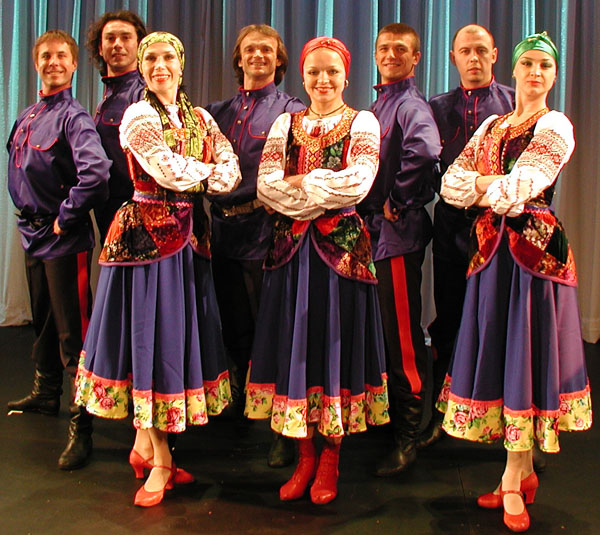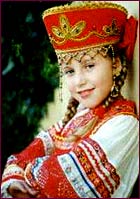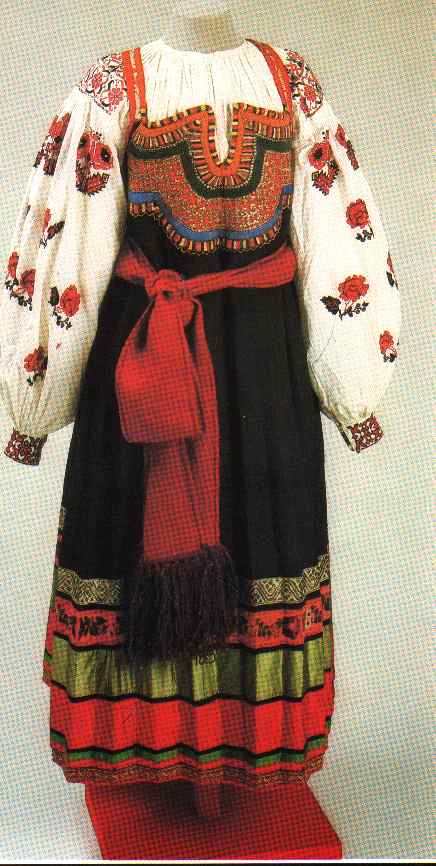source(google.com.pk)
Russian Traditional Dress Biography
The Russia of Nicholas II on the eve of World War I was a land of striking ethnic diversity. Comprising all of the republics of what later was to become the Soviet Union, as well as present-day Finland and much of Poland, Russia was home to more than 150 million people - of which only about half were ethnic Russians.
The variety of colors for traditional costume displays love for beauty and ethnic diversity. These costumes are not only beautiful, there are also convenient in wearing because they were created for work as well.
While clothes for noble people are introduced in the historical sources widely enough, there are not so many details for peasants' costumes.
Actually, until the 17th century it were only outside trimmings that differed from nobles' costumes to the peasants' ones, general cut and style were all the same.
Festive clothes and everyday clothes, married woman's and young girl's clothes differed only for details, decoration, color gamut.
Red fabric cloth was considered to be the nattiest one, and, by the way, the Russian word "beautiful" comes from the word "krasny", the Russian for "red".
Homemade canvas and wool clothes decorated with embroidery or woven pattern have been used most often for traditional peasant costumes.
Embroidery came in different ornaments (rhombuses, crosses, herring-bones, stylized patterns of people and animals) performed in naturally painted threads. Red, blue, green, white, yellow - the color gamut was rich and various.
Despite the social and territorial differences Russian traditional clothes had one thing in common, they had to be put as a cape, from the head. Soft silhouette without any cuts emphasized Russian lady's light steps. Dress and sleeves were getting wider to the lap; the fabric was decorated with symmetric pattern, or with other golden or silvery-like fabrics, furs, and embroidery.
Patterned woman's headdress "kokoshnik", fine linen "rubashka" shirts, beautiful woman's dress "sarafan" with embroidery in brocade and silk, - all these are comfortable and nice clothes worn ages ago by Russian women.
The most spectacular display of the traditional Russian costume is at the Russian Ethnographical Museum (formerly the Ethnographic Museum of the People of the USSR) in St Petersburg.
Russia has the best museum collections of "folk" costume worldwide and the Ethnographic Museum in St Petersburg is considered to be the best of its kind.
Under Stalin, the study and display of USSR folk arts served political ends.
The museum displays a total of 200,000 examples of folk art, mostly dated from the late 19th and early 20th centuries.
The museum also houses rotating exhibits of contemporary folk arts. All the costumes on display are high quality. Most notable are the costumes in the hall devoted to ethnic Russian peasant dress.
Fedoskino school of painting. The bride.Even though the main collection contains enough all by itself to absorb the most ardent of costume enthusiasts for an entire day there's still more!
The elusive "Gold Hall" houses valuable jewelry and jewel-encrusted costume accessories in a space like a bank vault. Another extra exhibit is in the central marble hall, between the two main galleries. The fabulous, sparkling exhibition, "The Emperor's Collection," has all that glitters in the way of costumes and jewelled objects.










Russian Traditional Dress Biography
The Russia of Nicholas II on the eve of World War I was a land of striking ethnic diversity. Comprising all of the republics of what later was to become the Soviet Union, as well as present-day Finland and much of Poland, Russia was home to more than 150 million people - of which only about half were ethnic Russians.
The variety of colors for traditional costume displays love for beauty and ethnic diversity. These costumes are not only beautiful, there are also convenient in wearing because they were created for work as well.
While clothes for noble people are introduced in the historical sources widely enough, there are not so many details for peasants' costumes.
Actually, until the 17th century it were only outside trimmings that differed from nobles' costumes to the peasants' ones, general cut and style were all the same.
Festive clothes and everyday clothes, married woman's and young girl's clothes differed only for details, decoration, color gamut.
Red fabric cloth was considered to be the nattiest one, and, by the way, the Russian word "beautiful" comes from the word "krasny", the Russian for "red".
Homemade canvas and wool clothes decorated with embroidery or woven pattern have been used most often for traditional peasant costumes.
Embroidery came in different ornaments (rhombuses, crosses, herring-bones, stylized patterns of people and animals) performed in naturally painted threads. Red, blue, green, white, yellow - the color gamut was rich and various.
Despite the social and territorial differences Russian traditional clothes had one thing in common, they had to be put as a cape, from the head. Soft silhouette without any cuts emphasized Russian lady's light steps. Dress and sleeves were getting wider to the lap; the fabric was decorated with symmetric pattern, or with other golden or silvery-like fabrics, furs, and embroidery.
Patterned woman's headdress "kokoshnik", fine linen "rubashka" shirts, beautiful woman's dress "sarafan" with embroidery in brocade and silk, - all these are comfortable and nice clothes worn ages ago by Russian women.
The most spectacular display of the traditional Russian costume is at the Russian Ethnographical Museum (formerly the Ethnographic Museum of the People of the USSR) in St Petersburg.
Russia has the best museum collections of "folk" costume worldwide and the Ethnographic Museum in St Petersburg is considered to be the best of its kind.
Under Stalin, the study and display of USSR folk arts served political ends.
The museum displays a total of 200,000 examples of folk art, mostly dated from the late 19th and early 20th centuries.
The museum also houses rotating exhibits of contemporary folk arts. All the costumes on display are high quality. Most notable are the costumes in the hall devoted to ethnic Russian peasant dress.
Fedoskino school of painting. The bride.Even though the main collection contains enough all by itself to absorb the most ardent of costume enthusiasts for an entire day there's still more!
The elusive "Gold Hall" houses valuable jewelry and jewel-encrusted costume accessories in a space like a bank vault. Another extra exhibit is in the central marble hall, between the two main galleries. The fabulous, sparkling exhibition, "The Emperor's Collection," has all that glitters in the way of costumes and jewelled objects.
Russian Traditional Dress

Russian Traditional Dress

Russian Traditional Dress

Russian Traditional Dress

Russian Traditional Dress

Russian Traditional Dress

Russian Traditional Dress

Russian Traditional Dress

Russian Traditional Dress

Russian Traditional Dress

Russian Traditional Dress
No comments:
Post a Comment